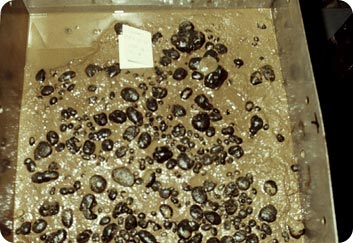A fortune is sitting at the bottom of the world’s oceans. And for the foreseeable future, at least, it’s likely to stay there.
 Manganese nodules contain manganese, iron, nickel, copper and other elements. Credit: National Oceanic and Atmospheric Administration
Manganese nodules contain manganese, iron, nickel, copper and other elements. Credit: National Oceanic and Atmospheric AdministrationThe fortune is locked up in small chunks known as manganese nodules. Most are about the size of potatoes, but some are bigger than a dining room table. Manganese makes up about a quarter of the typical nodule, with iron accounting for another five percent or so. But the nodules also contain fair amounts of nickel, copper, cobalt, and several other elements, along with smaller amounts of platinum and other precious metals.
Exactly how the nodules form is complicated and poorly understood. One thing scientists do understand is that it’s a slow process; in a million years, a nodule may grow by just a few millimeters -- the width of a few paperclips.
Manganese nodules may be strewn across half or more of the Pacific, especially in its broad, flat plains. They’re also common in the Indian Ocean, with some deposits in the other oceans as well. In all, they probably add up to billions of tons.
In the 1970s, several countries toyed with ways of bringing up the nodules. But they’re typically found at depths of a couple of miles or greater, so mining them is expensive. Treaties and environmental concerns have limited development, too.
Last year’s jump in commodities prices created a bit more interest in manganese nodules. Even so, the cost and other concerns mean that we’re not likely to see them being dredged from the ocean floor anytime soon.

